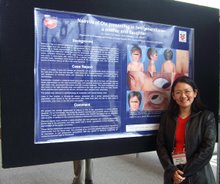Minocycline for EGFR-inhibitor associated skin rash

I was fortunate to be chosen as one of 20 presenters at the Residents & Fellows Symposium at the Annual Meeting of the American Academy of Dermatology (Washington DC, 2007). My presentation was on "PROPHYLAXIS WITH SYSTEMIC MINOCYCLINE AND TOPICAL TAZAROTENE (A RETINOID) FOR THE CETUXIMAB ASSOCIATED ACNE-LIKE ERUPTION". I presented on behalf of co-investigators Drs. Alon Scope, Stephen W. Dusza, Patricia L. Myskowski, Jocelyn Lieb, Leonard Saltz, Nancy E. Kemeny and Allan C. Halpern.
Cetuximab, an epidermal growth factor receptor inhibitor, is a biologically targeted agent that has been approved by the FDA for treatment of chemotherapy resistant/intolerant patients with metastatic colorectal carcinoma and unresectable squamous cell cancer of the head and neck. Cetuximab is associated with a characteristic dose-related follicular-pustular (acne-like) eruption affecting up to 90% of patients that is severe or dose-limiting in 10-20% of patients. Presently, there are no specific evidence-based treatments available for the inflammatory eruption. Patients are typically treated with dose modification, and empirically with drying agents, retinoids, steroids and antibiotics, but without evidence of consistent benefit.
This double-blinded randomized placebo-controlled single-center study aimed to assess the utility of topical tazarotene, oral minocycline or combination therapy for prevention of cetuximab-related rash. These agents were chosen based on anecdotal reports of their efficacy in cetuximab-related rash and their potential impact on follicular integrity and inflammation.
Patients with a diagnosis of colorectal cancer initiating cetuximab therapy were randomized to receive half-face twice a day topical therapy with tazarotene cream 0.01% and either oral minocycline (100mg daily) or oral placebo for two months. The primary endpoint in the study was the difference in total face lesion counts between minocycline- and placebo-treated patients at week 8. Secondary endpoints included the difference in total face lesion counts between minocycline- and placebo-treated patients at weeks 1-4 and difference in lesion counts between tazarotene-treated and observation sides of the face at weeks 1-8.
Forty eight eligible patients were randomly assigned to minocycline (n=24) or placebo (n=24). Median age was 44 years (range 38-83), with M: F (2:1) and 84% were white non-Hispanic. There was no significant difference between total facial lesions counts at week 8 between these groups. However, lesion counts were significantly attenuated in patients on minocycline at weeks 1-4. In 4 patients in the placebo- and in none in the minocycline-arm, cetuximab treatment was interrupted due to grade 3 skin adverse events. There was limited clinical benefit to tazarotene application.
We concluded that prophylaxis with minocycline was effective in decreasing severity of the acneiform rash during the first weeks of cetuximab therapy, suggesting that short-term minocycline prophylaxis for patients starting on cetuximab is beneficial.
 (Reunion of the MSKCC team at the AAD meeting in Washington DC. Top row, L-R, Ms Daphne Demas, Dr. Philip Spencer, Dr. Cristiane Benvenuto-Andarade, me, Dr. Patricia Myskowski, Dr. Alon Scope, Steve Dusza, Bottom row, L-R, Jules Lipoff, Dr. Jason Chen, Dr. Allan Halpern, Dr. Jocelyn Lieb)
(Reunion of the MSKCC team at the AAD meeting in Washington DC. Top row, L-R, Ms Daphne Demas, Dr. Philip Spencer, Dr. Cristiane Benvenuto-Andarade, me, Dr. Patricia Myskowski, Dr. Alon Scope, Steve Dusza, Bottom row, L-R, Jules Lipoff, Dr. Jason Chen, Dr. Allan Halpern, Dr. Jocelyn Lieb)



















No comments:
Post a Comment